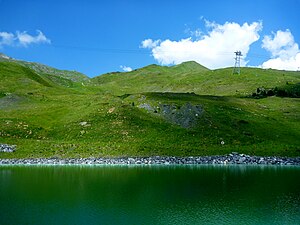Bruggerhorn
| Bruggerhorn | ||
|---|---|---|
|
The Brüggerhorn from the reservoir rear cabin seen |
||
| height | 2447 m above sea level M. | |
| location | Canton of Graubünden ( Switzerland ) | |
| Mountains | Alps | |
| Coordinates | 768 966 / 184898 | |
|
|
||
| rock | eastern alpine | |
| Development | Mountain hiking trails to the Sattelhütte and the Brüggerhorn chairlift (winter) | |
The Brüggerhorn ( formerly also Bruggersberg ) is 2447 m above sea level. M. high mountain peak in the Plessur Alps in the canton of Graubünden in Switzerland . It stands on the territory of the municipality of Arosa .
Location and description
The Brüggerhorn is part of the Central Plessurberge north-east of the Weisshorn , separated from it by the Weisshornsattel. The summit is essentially a grass hill, to the north in a sudden Schrofenhang sloping. It can be reached from the Sattelhütte on the leveled ski slope in around 10 minutes (level of difficulty T2 ). The summit offers the visitor a panoramic view of the Arosa mountain shell, the upper Schanfigg , Sapün and Fondei as well as the Prätschsee area . The name comes from the old Arosian family of "Brucker / Brügger", who owned extensive estates on the Brüggerhorn, but are no longer settled in the village today. Since May 28, 1966, the Brüggerhorn, together with the Schafrügg and the Schwarzsee, have been an absolute plant protection area.
Tourist development
The Brüggerhorn used to be a popular destination for ski tourers. Because of this, the Arosa ski club built the 2330 m above sea level at the north foot in 1911 . M. Brüggerhornhütte ( Ferdinandshütte ), which was replaced in its function in 1930 by the Weisshornhütte (today the Sattelhütte ). In 1938 the Arosa Bergbahnen opened the area with a drag lift . This facility, known as the Weisshorn or Sattellift, essentially followed today's ski slope from the terminus of the Riedlift to the Sattelhütte.
In 1970 the ski lift was demolished in favor of the Brüggerhorn two-seater chairlift, which leads from the middle station of the Weisshornbahn directly to the Brüggerhorn and is also open to pedestrians for ascent and descent. From there there is a transport cable car down to the Sattelhütte, which is logistically supplied this way. Alongside Hörnli - Urdental, the Brüggerhorn now forms the main mechanically developed Arosa freeride area with a long variant descent over the Chüeberg to Molinis . Winter hiking trails lead from the summit to the Weisshorn, to the Mittlere Hütte and into the Fuchs-Rot Tritt-Prätsch- Maran area .
When it was dismantled in 2019, the Brüggerhorn chairlift built by the Städeli company from Oetwil am See (WSO) was one of the oldest chairlifts in Switzerland that was largely in its original state. For 2015, the Arosa Bergbahnen planned to replace this system, which would lead to the Brüggerhorn on the previous line - and not from the valley station of the Tomeli lift, as was at times envisaged . For the purpose of evaluating alternative variants and for reasons of spring water protection, the construction project was initially postponed, but was finally implemented in the summer of 2019 in the form of a detachable 6-seater chairlift with wind protection hoods.
Sports events on the Brüggerhorn
For many years, alpine ski racing events have been held on the Brüggerhorn as part of the international three- peaks and three- piste races. Various routes were traveled, mostly from the pyramid directly over the Bäärgji to the LAW middle station or over the eastern flank through the Tomelitäli towards Prätschli. Today there is an FIS -homologated race track from the Schmidsch Steinen through the Sattelmulde and the Traxloch to the Mittleren Hütte, on which today's three-track races, mostly FIS speed competitions , take place. Winter, downhill and airboard races have also been held on this route .
literature
- Manfred Hunziker: Ringelspitz / Arosa / Rätikon , Alpine Touren / Bündner Alpen , Verlag des SAC 2010, ISBN 978-3-85902-313-0 , p. 301.
- Marcel Just, Christof Kübler, Matthias Noell (Eds.) Arosa - The Modern Age in the Mountains, gta Verlag, Zurich 2007, ISBN 978-3-85676-214-8 , p. 54 ff.
- Arosa Bergbahnen AG (Ed.): Bergfahrt - 75 years of mountain railways in Arosa, Weber AG, Thun-Gwatt 2005, ISBN 3-909532-30-6 , p. 38 f.
- Hans Danuser / SC Arosa (Ed.): 100 Years of Arosa Ski Club 1903-2003 , self-published by SC Arosa, Arosa 2003, pp. 64, 109.
- Hans Danuser: Arosa - as it was then (1947–1961) , Vol. 4, self-published by Danuser, Arosa 2000, p. 57.
- Hans Danuser, Ruedi Homberger: Arosa und das Schanfigg , self-published by Danuser / Homberger, Arosa 1988, p. 47 f.
Individual evidence
- ^ JB Casty: Arosa - From the local history of the world-famous health resort , Verlag Kur- und Verkehrsverein Arosa, Arosa 1959/60, p. 53 f.
- ↑ Aroser Zeitung of May 22, 2015, p. 5.
- ↑ Ride on the Brüggerhorn chairlift in 2014
- ↑ Aroser Zeitung of October 4, 2013, p. 3.



